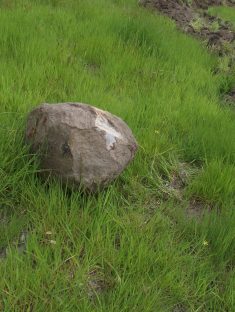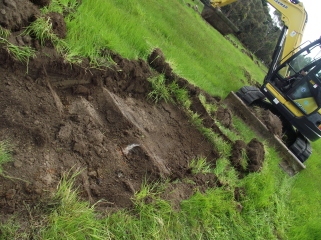This last week at our farm has been intense. It’s been all about the swales.

You can see this swale disappearing off into the western distance.
On Monday, after a few phone calls and a lot of planning, we booked in an 8 tonne excavator to help us dig out the swales I’d been busy marking out on the block. Our friend S has his excavator licence so he was happy, no keen, to dig out the swales.
Tuesday morning saw us all up at the crack of dawn to meet the excavator that was arriving at 8am. When it arrived at 10:30 we (less the kids who were at school by then) were keen to get started, so that’s what we did.

On of our smaller rocks. I think 2 of my children could hold hands around it.

Some of the larger ones.
We knew we had rocks through our pasture but never did we expect so many big rocks to be just under the grass. Pebbles the size of your fist to monsters the size of a human. Some were closer to the surface than others, but we have dug and dug and eventually, at around 5:30pm today, we overcame!
ALL the swales are complete!

Swales have another use outside of collecting water. Entertaining small boys who like to get dirty!
The swales are all running on contour. This means that as water flows downhill (or trickles as our slope is very shallow), the water will run into a swale. Each one runs for as long a distance as we could make it run, some half way across the block before heading back up to the northern boundary. If water was to fall on the north-eastern corner of the property it would enter into a small swale which, when full , will overflow over a carefully placed spillway that guides it into the next swale. That one will then fill, before it overflows into the next, and so on, until it reaches the south western corner of the farm. Each swale will stay full when it overflows, as will the dams, keeping a lot of water to rehydrate the soil.

Up close to a swale in process.
For those that don’t know swales, imagine those squiggly lines from a contour map, all about 1.5m wide, 20-30cm deep and all puddles!
In the future we hope to enlarge our current dam a little and install 2 others, each connected into a swale. This means when the dam fills it back-floods along the swale. If the swale captures water it will trickle (it’s designed to be flat) into the dam. Basically, any water entering into our farm will have a very long journey before it exits. From the north-east corner, our highest point, across the entire farm several times before exiting at the south-western corner into the swale drain along the roadside.
The reason I refer to carnage is due to the appearance. To most eyes we have butchered and ruined 20 acres of great pasture. To us, we are beginning to develop a truly sustainable farm.

The adventure begins!
LikeLiked by 1 person
It’s great you know the driver, so you can help each other build experience with swale construction. It might become a valuable service in the future, for other farms in the area. Future business perhaps?
I’m a tad envious of your gentle slope. 😉 Well done though. I’m certain those swales will add value to the property. Do you have any plans to plant them out with trees, or do you think it will run into conflict with your livestock?
LikeLiked by 1 person
Many many plans Chris. Plans that will incorporate our livestock. More on that in the future though.
As for swaling becoming a valuable service, that thought has crossed our minds. At the moment though, it’s tucked away for down the track.
LikeLike
Pingback: Oops I forgot to tell you but there was another post over at Twinny Acres. | Rabid Little Hippy
Slowly beginning to catch up here. It’s been interesting learning about swales (great pun, btw). We had a scythe, back in the day, and I loved using it. Never had a course, but I’d seen my Dad and other men use one, so it came pretty naturally. I know more all the time now just how lucky I was, growing up then. Looking forward to your continuing adventures/
LikeLiked by 1 person
Well, here I am again! Hope the long radio silence is the sound of much going on; so long as ‘much’ has not been overwhelming. Thinking of you so often. Now I must go and work on at least one post myself LOL
LikeLike